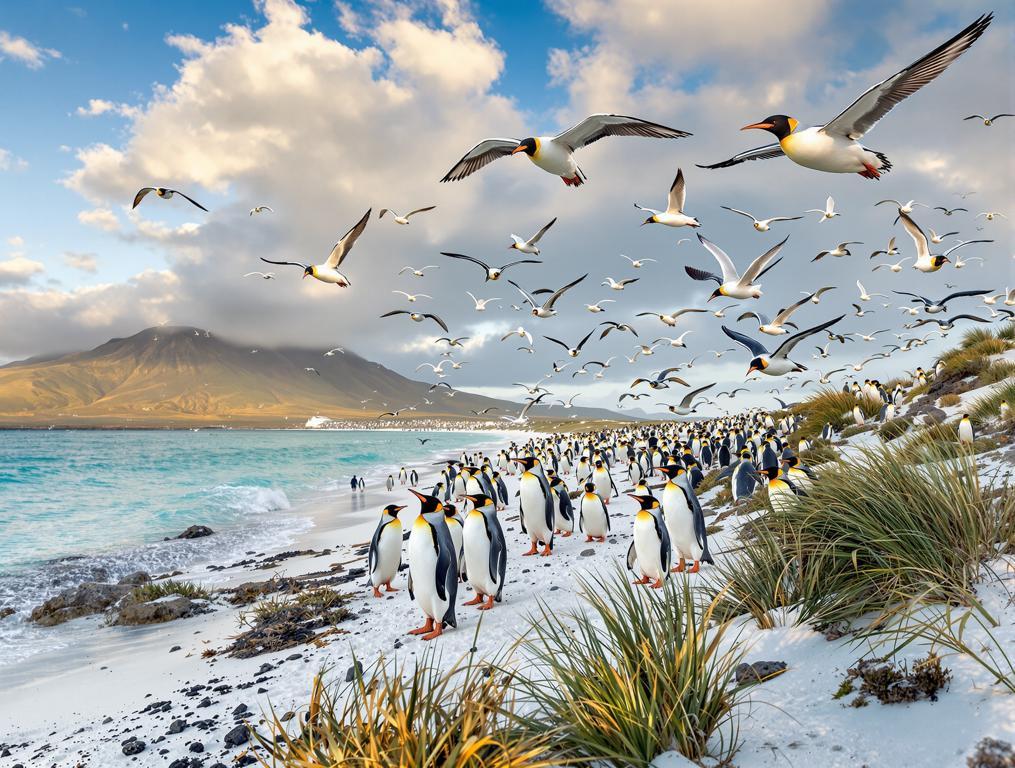The wind slaps my face as I step onto the white sand beach of Saunders Island. I pause, suddenly aware that I’m being watched—not by the 7 human residents of this remote Falkland Islands outpost, but by thousands of curious eyes. Black-browed albatrosses soar overhead while four different penguin species waddle along the shoreline. The numerical imbalance is staggering: 11,000 breeding pairs of albatrosses alone outnumber humans by a ratio of 3,142:1. Standing here, 400 miles east of South America’s southern tip, I’ve never felt so gloriously outnumbered.
Where 7 people share beaches with 40,000+ seabirds
The Poole-Evans family has owned this 50-square-mile sheep farm for generations. But they share their island with some extraordinary neighbors: more than 40,000 nesting seabirds including the Falklands’ largest colony of black-browed albatrosses.
“We’re just temporary caretakers,” David Poole-Evans tells me as we watch a group of Gentoo penguins waddle past his front yard. The family manages the delicate balance between working sheep farm and wildlife sanctuary—a rare model of sustainable coexistence.
Walking along the narrow isthmus locals call The Neck, I’m surrounded by a cacophony of calls. Rockhopper penguins hop comically between rocks while Magellanic penguins emerge from burrows beneath tussock grass. Overhead, albatrosses with their impressive 8-foot wingspans glide effortlessly on thermal currents.
Most remarkable is the King penguin colony—striking with their bright orange neck patches. Unlike their Antarctic cousins, these Kings breed year-round, meaning fluffy brown chicks stand among adults regardless of when you visit. The island’s status as an Important Bird Area (IBA) understates its significance; it’s a living laboratory of avian abundance.
Four penguin species in one location outshines famous South Georgia
While South Georgia Island attracts thousands of tourists annually, Saunders offers something its famous neighbor can’t: four penguin species breeding in close proximity. Even South Georgia, with its massive King penguin colonies, hosts only two penguin species.
“I’ve visited wildlife sanctuaries across seven continents, but nowhere else can you eat breakfast watching sheep graze, then walk 15 minutes to find yourself surrounded by four different penguin species and thousands of albatrosses.”
The experience feels more authentic than similar destinations like gateway towns to pristine islands. Unlike many wildlife destinations, Saunders’ limited accessibility—boat access only—has preserved its ecological integrity.
What makes this place truly special is the juxtaposition. Where else can you watch sheep grazing peacefully on hillsides while penguins navigate the beaches below? This integration of traditional farming with critical habitat preservation creates an environmental harmony rarely seen elsewhere.
The island’s pioneering approach to balanced land use mirrors strategies employed by towns balancing tourism with preservation, proving that human activity and wildlife conservation can coexist when thoughtfully managed.
How to experience this extraordinary wildlife ratio
Visiting requires planning—especially considering today’s date (June 25, 2025) falls during the Falklands winter. The optimal window is October through March, when seabird colonies are most active and weather conditions improve.
Accommodation options include staying at The Settlement with the Poole-Evans family or the more remote cottage at The Neck—placing you literally between penguin colonies. Book months in advance; with just two accommodation options for an island this exceptional, spaces fill quickly.
Like ancient land bridges where mammoths once roamed, Saunders preserves an ecosystem largely unchanged for millennia. While not as frigid as towns that regularly hit -57°F, winter visits offer dramatic landscapes and the island’s residents adapted to these harsh conditions.
For the best experience, arrange transportation through Stanley-based operators, with flights to the Falklands available weekly from Chile or the UK. The unpredictability of Falklands weather means building flexibility into your schedule—but that’s part of the adventure.
Why winter planning offers the best summer wildlife experience
While I stand here in June—winter in the Southern Hemisphere—I’m already planning my return during the December breeding season. The current quiet period is perfect for researching and booking accommodations that will be impossible to secure last-minute.
As I watch albatrosses ride air currents above these pristine beaches, I realize Saunders Island offers something increasingly rare: a place where humans haven’t tipped the balance. Here, we remain gloriously, numerically insignificant—temporary visitors in a world where wildlife still sets the rules.
